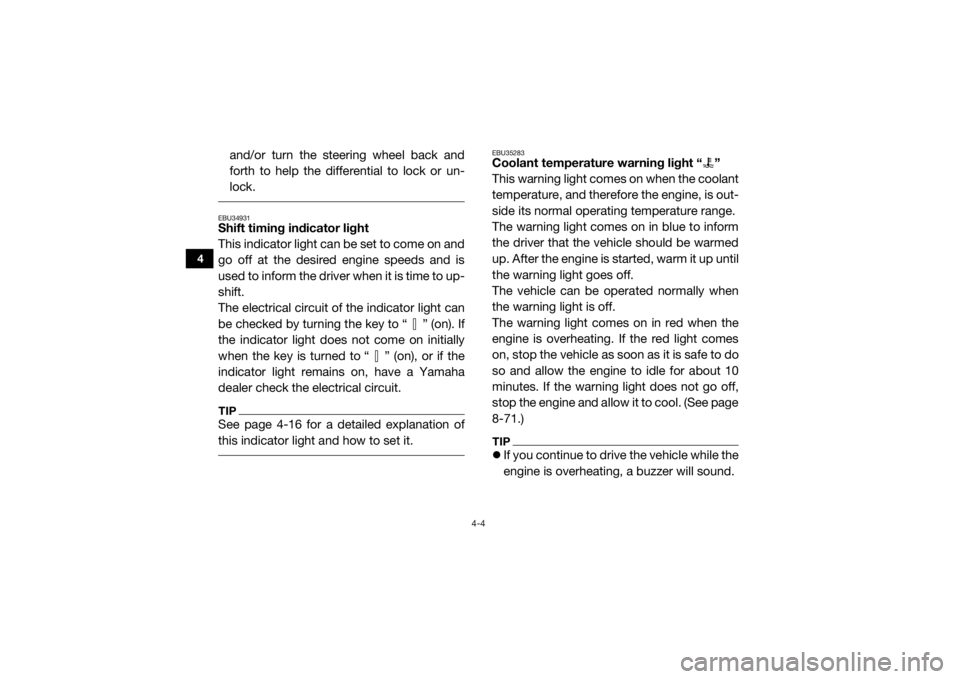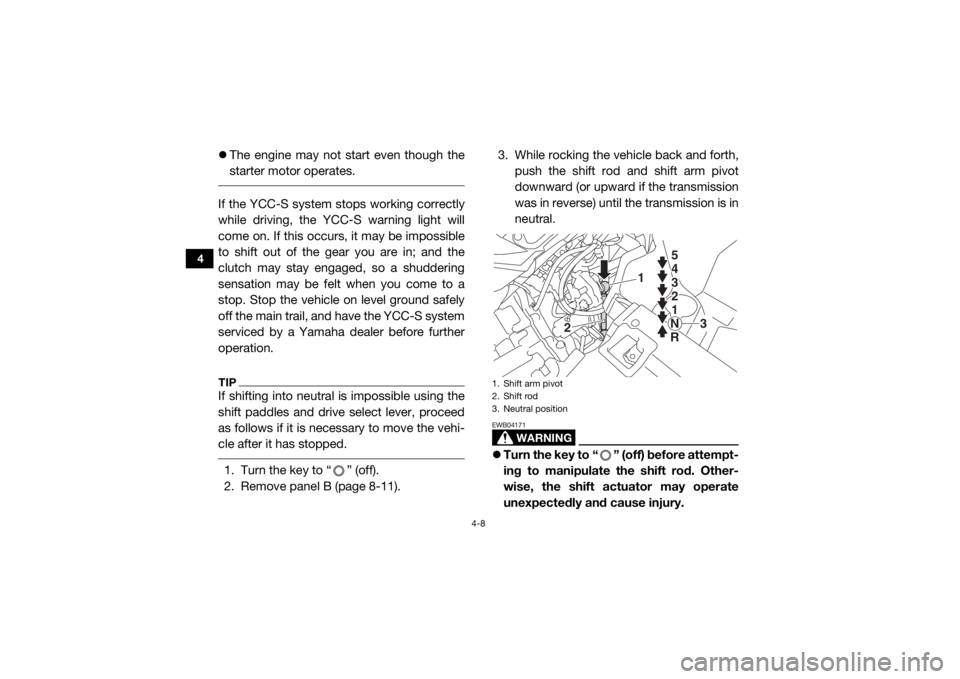stop start YAMAHA YXZ1000R SS 2019 Owners Manual
[x] Cancel search | Manufacturer: YAMAHA, Model Year: 2019, Model line: YXZ1000R SS, Model: YAMAHA YXZ1000R SS 2019Pages: 218, PDF Size: 9.48 MB
Page 34 of 218

4-4
4
and/or turn the steering wheel back and
forth to help the differential to lock or un-
lock. EBU34931Shift timing indicator light
This indicator light can be set to come on and
go off at the desired engine speeds and is
u s ed t o i n fo rm t h e dr iv er wh e n it i s ti m e t o u p -
shift.
The electrical circuit of the indicator light can
be checked by turning the key to “ ” (on). If
the indicator light does not come on initially
when the key is turned to “ ” (on), or if the
indicator light remains on, have a Yamaha
dealer check the electrical circuit.TIPSee page 4-16 for a detailed explanation of
this indicator light and how to set it.
EBU35283Coolant temperature warning light “ ”
This warning light comes on when the coolant
temperature, and therefore the engine, is out-
side its normal operating temperature range.
The warning light comes on in blue to inform
the driver that the vehicle should be warmed
up. After the engine is started, warm it up until
the warning light goes off.
The vehicle can be operated normally when
the warning light is off.
The warning light comes on in red when the
engine is overheating. If the red light comes
on, stop the vehicle as soon as it is safe to do
so and allow the engine to idle for about 10
minutes. If the warning light does not go off,
stop the engine and allow it to cool. (See page
8-71.)TIPIf you continue to drive the vehicle while the
engine is overheating, a buzzer will sound.
UB5H7AE0.book Page 4 Wednesday, July 4, 2018 1:37 PM
Page 37 of 218

4-7
4
EBU36643Launch system indicator light “ ”
This indicator light comes on when the launch
system is activated. If the indicator light is
flashing, either a user error or system restric-
tion has been detected. See “Launch system
operation” on page 6-7 for more information.
The electrical circuit of the indicator light can
be checked by turning the key to “ ” (on). If
the indicator light does not come on and then
go off, have a Yamaha dealer check the elec-
trical circuit.TIPIf the launch system indicator light is flashing,
release the accelerator pedal and shift pad-
dles to reset the system. When the engine
speed returns to idle, the indicator light will go
off. You can now start off as normal in first
gear, or retry activating the launch system.
EBU36743YCC-S system warning light “ ”
This warning light comes on when an error
has occurred or a malfunction has been de-
tected in the YCC-S system. Have a Yamaha
dealer check the YCC-S system.
The electrical circuit of the YCC-S system
warning light can be checked by turning the
key to “ ” (on). If the warning light does not
come on and then go off, have a Yamaha
dealer check the electrical circuit.
If the YCC-S system warning light flashes
when starting the engine, wait 3 seconds for
the light to stop flashing, and then retry start-
ing the engine. If an error in the YCC-S sys-
tem prevents the engine from starting, the
warning light will come and the display will in-
dicate an error code.TIPYCC-S system error codes are visible only
when the engine is stopped.
UB5H7AE0.book Page 7 Wednesday, July 4, 2018 1:37 PM
Page 38 of 218

4-8
4
The engine may not start even though the
starter motor operates. If the YCC-S system stops working correctly
while driving, the YCC-S warning light will
come on. If this occurs, it may be impossible
to shift out of the gear you are in; and the
clutch may stay engaged, so a shuddering
sensation may be felt when you come to a
stop. Stop the vehicle on level ground safely
off the main trail, and have the YCC-S system
serviced by a Yamaha dealer before further
operation.TIPIf shifting into neutral is impossible using the
shift paddles and drive select lever, proceed
as follows if it is nece ssary to move the vehi-
cle after it has stopped. 1. Turn the key to “ ” (off).
2. Remove panel B (page 8-11). 3. While rocking the vehicle back and forth,
push the shift rod and shift arm pivot
downward (or upward if the transmission
was in reverse) until the transmission is in
neutral.
WARNING
EWB04171Turn the key to “ ” (off) before attempt-
ing to manipulate the shift rod. Other-
wise, the shift actuator may operate
unexpectedly and cause injury.1. Shift arm pivot
2. Shift rod
3. Neutral position
1
2
3
5 5
4
3
2
1
N
R 5
4
3
2
1
N
R
UB5H7AE0.book Page 8 Wednesday, July 4, 2018 1:37 PM
Page 100 of 218
![YAMAHA YXZ1000R SS 2019 Owners Manual 6-4
6
TIPTo use the drive select lever, you must be
pressing the brake pedal and be stopped
(be traveling less than 5 km/h [3 mph]), and
the engine should be at idle speed.
You can shift betwee YAMAHA YXZ1000R SS 2019 Owners Manual 6-4
6
TIPTo use the drive select lever, you must be
pressing the brake pedal and be stopped
(be traveling less than 5 km/h [3 mph]), and
the engine should be at idle speed.
You can shift betwee](/img/51/53887/w960_53887-99.png)
6-4
6
TIPTo use the drive select lever, you must be
pressing the brake pedal and be stopped
(be traveling less than 5 km/h [3 mph]), and
the engine should be at idle speed.
You can shift between forward (first gear)
and reverse gear directly - it is not neces-
sary to shift into neutral.
When using the shift paddles, YCC-S may
not complete the upshift if engine or vehicle
speed is too low, nor complete the down-
shift if engine or vehicle speed is too high.
When AUTO DOWNSHIFT is downshifting
gears, do not operate the shift paddles or
accelerator pedal.
During an emergency stop or sudden brak-
ing, AUTO DOWNSHIFT will not downshift
the transmission to first gear. Use the shift
paddle “ ” to downshift, and then apply
the accelerator pedal to resume normal op-
eration.
NOTICEECB03370Even with the transmission in the neutral
position, do not coast for long periods of
time with the engine off. The transmission
is properly lubricated only when the engine
is running. Inadequate lubrication may
damage the transmission. To start out and accelerate
1. Take your foot off the accelerator pedal
and apply the brake pedal. NOTICE: Al-
ways take your foot off the accelerator
pedal before operating the drive select
lever, otherwise damage to the engine
and drivetrain may result.
[ECB03360]
2. Release the parking brake (if applied).
3. Shift into first gear using the drive select lever (the transmission gear display
should show “1”).
4. Release the brake pedal and press the accelerator pedal gradually.
UB5H7AE0.book Page 4 Wednesday, July 4, 2018 1:37 PM
Page 128 of 218

7-19
7
over. Practice first on gentle slopes before at-
tempting steeper hills. Always check the
terrain carefully before attempting any hill.
To climb a hill, you need traction, momentum,
and steady throttle. For more traction and
control for climbing steeper and/or rougher
slopes, shift into low gear and select “4WD”
or “DIFF LOCK”. Travel fast enough to main-
tain momentum, but not so fast that you can-
not react to changes in the terrain as you
climb.
Slow down when you reach the crest of the
hill if you cannot see clearly what is on the
other side – there could be another person, an
obstacle, or a sharp drop-off.
If you start to lose traction or momentum
when climbing, and decide you will be unable
to continue, use the brakes to stop. Do not at-
tempt to turn the vehicle around. With your
foot on the brake pedal, look behind you and
plan your descent. Shift the transmission into
reverse so you can use engine braking to
slow your descent. Release the brake, andthen begin to coast down the hill. Use engine
braking as much as possible, gently applying
the brakes when necessary.
Downhill
Check the terrain carefully before going
downhill. When possible, choose a path that
lets you drive your vehicle straight downhill.
Choose your path carefully and drive slowly
enough to be able to react to obstacles that
you encounter.
For more traction and control, before going
down steeper and/or rougher slopes, shift
into low gear and select “4WD” or “DIFF
LOCK”. Engine braking will help you go
downhill slowly. Go as slowly as possible. If
you begin to go too fast, apply the brakes
gently. Avoid hard application of the brakes,
which could cause the vehicle to slide.UB5H7AE0.book Page 19 Wednesday, July 4, 2018 1:37 PM
Page 130 of 218

7-21
7
Wet brakes may have reduced effectiveness.
After leaving the water, test the brakes. If nec-
essary, apply the brakes several times to let
friction dry them out.NOTICEECB02950After driving your vehicle in water, be sure
to drain the trapped water by removing the
check hoses at the bottom of the air filter
case. Wash the vehicle in fresh water if it
has been operated in salt water or muddy
conditions. Loose terrain/slippery terrain
When driving on slippery terrain, including
wet, muddy, or icy conditions, as well as
loose gravel, be aware that you could begin
skidding or sliding. To avoid loss of control,
slow down and put the vehicle in four-wheel
drive before driving on a slippery surface and
plan your path to avoid making abrupt ma-
neuvers. If you feel the vehicle begin to slide sideways
or fishtail (rear-wheel sliding), steer into the di-
rection of the slide if possible, to regain direc-
tional control. For example, if you feel the
back of the vehicle start
to slide to your right,
steer to the right.
Brush or wooded areas
When operating in areas with brush or trees,
watch carefully on both sides and above the
vehicle for obstacles such as branches that
the vehicle might hit, causing an accident.
Watch for brush that might enter the vehicle
as you pass and strike you or the passenger.
Never hold onto the cage/frame. The passen-
ger should always hold onto the passenger
handhold with both hands.
The muffler and other engine parts become
extremely hot during operation and remain
hot after the engine has stopped. To reduce
the risk of fire during operation or after leaving
the vehicle, do not let brush, grass and other
materials collect under the vehicle, near theUB5H7AE0.book Page 21 Wednesday, July 4, 2018 1:37 PM
Page 154 of 218

8-23
8
TIPBe sure to wipe off spilled oil on any parts af-
ter the engine and exhaust system have
cooled down. 16. Install and tighten the engine oil tank fillercap.
17. Start the engine and let it idle for several minutes. During this time, check for oil
leakage. If any oil leaks are found, stop
the engine and check for the cause.
18. Stop the engine, wait at least ten minutes, and then check the oil level one last time.
19. Install the engine oil tank cover by install- ing the bolts.
20. Install the panel.
To change the engine oil and oil filter
1. Park the vehicle on a level surface.
2. Loosen the left and right side panels by removing the bolt as shown. 3. Remove the rear bottom panel by remov-
ing the bolts.
1. Left side panel
2. Right side panel
3. Bolt
3
1
3
2
UB5H7AE0.book Page 23 Wednesday, July 4, 2018 1:37 PM
Page 162 of 218

8-31
8
6. Check the O-ring for damage, and re-place it if necessary.
7. Refill the transmission with the specified amount of the recommended oil.
8. Install the transmission oil filler cap.
9. Start the engine and let it idle while checking for oil leakage.
10. Stop the engine and check the oil level one last time.EBU36053Final gear oilCheck the oil level and change the final gear
oil at the intervals specified in the general
maintenance and lubrication chart.
NOTICEECB03590When checking or changing the final gear
oil, make sure that no foreign material en-
ters the final gear case. If necessary, clean
the final gear oil filler bolt and surrounding
area. TIPIf the recommended gear oil is not available,
SAE 80W-90 API GL-4 or GL-5 hypoid gear
oil may be used instead. Checking the final gear oil level1. Park the vehicle on a level surface.
Tightening torque: Transmission oil drain bolt:20 N·m (2.0 kgf·m, 15 lb·ft)
Recommended oil:SAE 80 API GL-4 Hypoid gear oil
Oil quantity: 0.47 L (0.50 US qt, 0.41 Imp.qt)
UB5H7AE0.book Page 31 Wednesday, July 4, 2018 1:37 PM
Page 176 of 218

8-45
8
EBU35141Cleaning the spark arrester
WARNING
EWB03370Hot exhaust system may cause burns. To
avoid burns or fires, make sure that the en-
gine is stopped and the exhaust system is
cool before cleaning the spark arrester. Do
not start the engine while cleaning the ex-
haust system. 1. Remove the tailpipe cover by removingthe tailpipe cover bolts.
1. Air filter case check hose
1. Air filter case check hose
1
1
1. Tailpipe cover
2. Tailpipe cover bolt
1
2
2
UB5H7AE0.book Page 45 Wednesday, July 4, 2018 1:37 PM